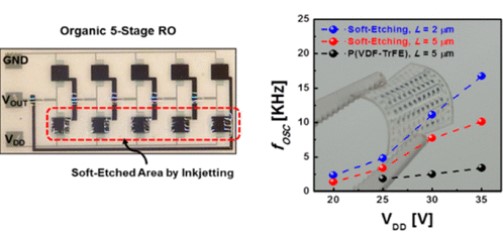Inkjet-Printing-Based Soft-Etching Technique for High-Speed Polymer Ambipolar Integrated Circuits
- 저자
- Dongyoon Khim, Kang-Jun Baeg, Minji Kang, Seung-Hoon Lee, Nam-Koo Kim, Jihong Kim, Geon-Woong Lee, Chuan Liu, Dong-Yu Kim* and Yong-Young Noh*
- 저널명
- ACS Applied Materials & Interfaces, 5, 23, 12579-12586 (2013)
- 년도
- 2013
- Link
- http://dx.doi.org/10.1021/am4039008 915회 연결
[Abstract]
Here, we report the so-called soft-etching process based on an inkjet-printing technique for realizing high-performance printed and flexible organic electronic circuits with conjugated polymer semiconductors. The soft-etching process consists of selective etching of the gate made of a dielectric polymer and deposition of another gate dielectric layer. The method enables the use of a more desirable polymer dielectric layer for the p-channel and n-channel organic field-effect transistors (OFETs) in complementary integrated circuits. We fabricated high-performance ambipolar complementary inverters and ring oscillators (ROs) using poly([N,N′-bis(2-octyldodecyl)-naphthalene-1,4,5,8-bis(dicarboximide)-2,6-diyl]-alt-5,5′-(2,2′-bithiophene)) (P(NDI2OD-T2)) as the active layer as well as poly(vinylidenefluoride-trifluoroethylene) (P(VDF-TrFE)) and polystyrene ((PS)/P(VDF-TrFE)) as dielectric materials for the p-channel (pull-up transistor) and n-channel (pull-down transistor) OFETs, respectively. The PS dielectric polymer was selectively etched by inkjetting of n-butyl acetate as an orthogonal solvent for P(NDI2OD-T2). Employing this methodology, the five-stage ambipolar ROs with P(NDI2OD-T2) exhibited an oscillation frequency of ∼16.7 kHz, which was much higher than that of non-soft-etched ROs with a single dielectric layer (P(VDF-TrFE); ∼3 kHz).
